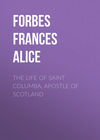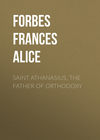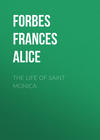Loe raamatut: «The Life of Saint Columba, Apostle of Scotland», lehekülg 2
CHAPTER II
THE SCHOOLING OF A SAINT
WHILE Columba was growing into manhood among the mountains of
Tir-Connell, St. Finnian, "Finnian of the Heart Devout" as the old writers love to call him, was founding his great monastic school of
Moville on the northern side of Lough Cuan.
Not on his piety and sanctity alone did the renown of Finnian rest. He had been educated at the famous monastery of Whitehorn, founded by St. Ninian in the fourth century in the British kingdom of Galloway across the sea. St. Ninian was the friend of St. Martin of Tours, and it was from him that he obtained masons to build the Candida Casa or White House, the first stone church erected in Britain. Later, St. Finnian went on pilgrimage to Rome, a difficult and dangerous undertaking in days when ships consisted for the most part of a framework of willow overstretched with ox-hide; and famine, pestilence, wild beasts and barbarians were only a few of the perils that beset travellers by land. There he remained for three months, when he returned to Ireland, bringing with him a precious and priceless treasure.
This was a copy of the sacred Scriptures, translated and corrected by the hand of St. Jerome himself, and formally sanctioned by the Pope as the authentic text. No copy of this first edition of the Vulgate had as yet found its way into Ireland, and to the scholars and scribes of the day it was of untold worth.
The school of Moville was founded in 540, and St. Columba must have been one of its earliest scholars, for he was born in the year 521, and was about twenty years of age when he left Tir-Connell. Here he was ordained deacon, and here also, at his prayer, was worked the first of a long series of miracles that were to continue throughout his life. One festival day, to the consternation of St. Finnian, it was found that there was no wine for the Holy Sacrifice. It was the turn of Columba to draw the water that was to be used in the sacred mysteries, and kneeling at the brink of the well he prayed earnestly to that Lord who had changed water into wine at the marriage feast of Cana to have pity on their distress. His prayer was heard; even as he carried the water to the church the miracle was worked.
"Here, my Father, is wine that God has sent us from heaven," said the young deacon, as he gave the vessel to his master, and Finnian marvelled greatly and gave praise and glory to God.
From Moville, Columba went to the great school of Clonard, there to pursue his studies under another St. Finnian – Finnian the Wise, the "Tutor of the Saints of Erin." Clonard was the most famous school in Ireland at the time, and even bishops and abbots, old in years and experience, did not disdain to come to learn wisdom at the feet of its holy founder. St. Finnian of Clonard had been himself the pupil of three great saints, St. David, St. Gildas, and St. Cadoc, at the College of Llancarvan in Wales. When Columba came to the school of Clonard it numbered, as the old writers tell us, three thousand scholars.
The problem of accommodation was very simple in an Irish school of the sixth century. A few precious manuscripts formed the whole library. The instruction was mostly oral, and given in the green fields round the moat of Clonard. A little hill or eminence formed the professor's chair, and the scholars sat on the slopes about his feet. They built their own little huts of clay and wattles in the surrounding meadows, and took their turn at herding the sheep and grinding in the quern, or handmill, the corn for the daily bread. They prayed and studied, learnt the exquisitely fine transcription that gave to the world the only books that were then to be had, and listened to the interpretation of the Holy Scriptures expounded by St. Finnian with a power and eloquence that drew men from all parts of Ireland to listen.
The son of the Hy-Nialls took his turn with the rest at grinding the corn in the quern and in the humble daily labours, but he accomplished his task so rapidly and skilfully that his fellow-scholars, who may have heard the story of the celestial companion of his boyhood, would assert that he had been helped by an angel. When the daily work was finished, he was always to be found, as of old, before the altar, absorbed in prayer. Even the elders treated him with deference. There was something so noble and commanding in his bearing, so high and holy in the glance of his keen grey eyes, so strong and compelling in the clear tones of his voice, that half unconsciously men bowed before him.
But there was one at Clonard who long withstood his influence. To the gentle-hearted Ciaran "Mac In Tsair," or the son of the carpenter, temptation had come in the shape of an envious thought.
Why should Columba, he asked himself resentfully, be loved and privileged above all the other scholars? He was the son of the Prince of Tir-Connell it was true, but in a monastic community such as Clonard were not they all equal before God? He began to be jealous of the influence exercised so unconsciously by his young companion, and harboured bitterness in his heart. Ciaran's guardian angel grieved over the havoc that was being wrought in that pure and gentle soul. He appeared to him one day in a radiant vision, carrying the tools of a carpenter in his hands.
"See, Ciaran," said he, "what thou hast left for the love of God, to give thyself to Christ in the monastic life; but Columba has sacrificed the throne which would have been his, had he not, forsaking the world, chosen rather to follow his Lord in poverty and humiliation."
His words scattered the mist of envy from the heart of the carpenter's son, who humbly asked pardon for his sin. From henceforth he became one of the warmest friends of Columba, who in his turn loved the gentle-hearted Ciaran with a true and tender affection. It was while the two were at Clonard together that their master St. Finnian dreamt that he saw two moons, one of gold and one of silver, shining in the sky. The golden moon illuminated the north of Ireland, and its beams shone over the sea as far as distant Alba, while the moon of silver shed its soft light in the centre of the land. It was made known to Finnian that the golden moon represented Columba, who was to carry the light of the Gospel to another people, while that of silver typified Ciaran, whose holiness was to be a light to many in his own country.
It was at this time that Columbcille showed the first signs of that gift of prophecy that was to make him so famous in after days.
There came to Clonard an old bard called Gemman, who was a Christian. Columba, who had a passionate love for poetry, put himself under his tuition that he might not only study the old minstrel lore of Ireland, but learn also to pour out his own heart in song. One day when the old man sat reading at a little distance from his pupil in the green meadows near Clonard, a young maiden, crying piteously for help, and hotly pursued by one of the bloodthirsty barbarians who were the terror of the more peaceful inhabitants of the country, fled towards him for protection. Gemman called to Columba for help, but it was too late. Even as he tried to hide the child under the folds of his long cloak her savage assailant pierced her to the heart with his spear.
"How long, O Lord," moaned the old man, as he gathered the body of the little maiden into his arms, "how long shall the blood of this innocent cry unavenged to heaven?"
Columba turned to him with flashing eyes.
"Thus long," he cried in a voice that rang like the trumpet of the avenging angel:
"Thus long, and no longer. The soul of that innocent child shall scarcely have entered heaven before the soul of her murderer shall be cast into eternal fire."
The words had scarcely left his lips when the barbarian, who was not yet out of sight, fell dead, struck down by the sudden judgment of God.
On leaving Clonard, Columba went in company with the gentle-hearted Ciaran to visit the school of another great master of the spiritual life, St. Mobhi of Glasnevin. There they met St. Comgall and St. Cannich, and formed with them a lifelong friendship. It was during his stay at Glasnevin that Columba was sent by St. Mobhi to Etchen, Bishop of Clonfad, to be ordained a priest, and it is characteristic of the simplicity of the times that the holy bishop, who was Columba's own cousin, and the son of a reigning prince, was found in the fields guiding the oxen of his plough.
It must have been also about this time that Ciaran and Columba journeyed together to the rocky Isle of Aran in the west, to visit St. Enda the Holy, the tutor of both Finnian of Moville and Finnian of Clonard. Aran was indeed a very nursery of sanctity, and Enda was reverenced as a father by all the saints of Ireland. They learnt from his lips the virtues and duties of a true monk, but they learnt still more from his example. He and his community slept on the bare ground in their stone cells, never warmed by a fire even in the coldest days of winter. Their frugal food was the fruit of the labour of their hands, but it was little enough that the barren rocks of Aran could furnish. To these men, whose hearts were on fire with the love of God, their desert island was a little paradise, where they lived in close communion with the unseen world, and from whence the voice of praise went up incessantly to the throne of God.
We are told that the gentle-hearted Ciaran, the son of the carpenter, was beloved by Enda above all his disciples, and that when the time came for him to leave the Isle of Aran to found his own great monastery of Clonmacnoise on the banks of the Shannon, the old man knelt and wept bitterly on the rocky shore. Perhaps he may have foreseen the early death of his beloved pupil, the sudden quenching of that light that was to shine so brightly during the few years that remained to him of his earthly pilgrimage.
For a few years after his departure from Aran the holy Ciaran exercised his apostleship in his native country, and then founded the monastery of Clonmacnoise, which in after days was to become the greatest and most learned community in Ireland. Four months later a terrible pestilence broke out, and the gentle Ciaran was amongst its victims. He asked the brethren to take him out into the open air that his eyes might see the blue sky once again before he died. The skin on which he used to sleep was spread on the ground and they laid him on it, weeping bitterly the while. The dying man then asked to be left alone with St. Kevin of Glendalough, his soul's friend (the beautiful old Celtic name for spiritual father – still in use among the Catholics of western Scotland), who blessed him and gave him the Holy Communion.
Ciaran bade him a tender farewell, for, says the old chronicle, he loved him much. Then, lifting his eyes to heaven with a smile on his lips, the pure and holy Ciaran breathed his last, and white angels came and carried his soul to Paradise.
CHAPTER III
DERRY AND DURROW
THE terrible outbreak of plague that carried off young Ciaran in the flower of his age found Columba at Glasnevin. St. Mobhi bade his disciples disperse to their homes, and Columbcille went northwards to Tir-Connell. When he reached the stream of Moyola he prayed earnestly that God might stay the plague on the southern bank of the river, and spare the country of his people. His prayer was heard, and the terrible scourge forbore to cross the water.
Columba was now twenty-five years of age, and his friends and kinsmen earnestly desired that he should found a church and monastery in their own country. His cousin the Prince of Ailech even offered him a piece of land on the northern coast, but Columba was deaf to their entreaties. His master, St. Mobhi, had given him no permission to found; and without it, so great was his reverence for the holy old man, he would take no steps in the matter. But Mobhi had fallen a victim to the pestilence and was sick unto death. One of his last acts was to send messengers in search of his beloved disciple, to take him his blessing and his girdle in token that the time had come for him to found his monastery.
The spot that Ailech had offered to Columba was altogether after his own heart and was now most gratefully accepted. The so-called "island" of Derry or Daire, surrounded as it was on two sides by the Foyle water and on the third by a marsh, consisted of a gently rising green hill, crowned on the summit with a beautiful wood of oaks. So dear was the oak grove of Derry to Columbcille, that rather than cut down one of its trees, he preferred to build his church in the space that remained between them.
The cells of the monks were placed at the foot of the hill by the water's edge, and it was not long before the young men of Tir-Connell came flocking to Daire to give themselves to the service of God under the rule of their young kinsman.
It was in this beloved church of Derry that it was given so often to Columba to behold the angels adoring their Lord on His altar throne, and to hear the melody of their voices as they sang the eternal song of praise.
Prayer, labour, and study divided the hours of the day, and young as was the abbot, the hand that governed, though gentle, was very firm. Columba had learnt from his holy masters in the spiritual life to lead his monks by example even more than by precept. He slept on the bare ground, with a skin for covering and a stone for pillow. Three times in the night he rose to pray, and his food was of the scantiest and poorest description. "Though my devotion is great," he would say, "I sit in a chair of glass, for I am frail and fleshly." No work was too menial for him, and he would carry the sacks of grain on his strong shoulders from the mill to the kitchen like the humblest brother. His austerities were the admiration of his monks, who strove in all things to follow the example set before them.
Of all the foundations of Columba, and we are told of no less than thirty-seven, Derry was the one that remained always the dearest to his heart, and many of the sweet songs of his making celebrate its praises.
The reason I love Daire is
For its peace and its purity,
And for its crowds of white angels
From one end to the other.
My Daire, my little oak grove,
My dwelling, my dear little cell;
O Eternal God in Heaven above,
Woe be to him who violates it, sings the Saint in the soft Erse or Gaelic of his native land. "On every leaf of the oaks of Derry," he would say, "there sits a white angel listening to the brethren as they sing the praises of God."
The dear oak trees of Derry were never to be cut down, and if one were uprooted by the storm it was to lie for nine days before it was divided between the poor and the guest-house of the monastery.
There was a hamlet on the northern side of the hill, and a hundred poor were fed every day by the monks of Derry. Once during a thunderstorm some of the wretched little houses caught tire. The people hastened to Columba, who went at once to the church. There with outstretched arms he poured forth his soul in supplication before the altar, and the fire ceased at his prayer.
A fragment of the rule in use amongst the old Celtic monasteries has been preserved, in which we can see the spirit of the monks of Columba's time:
"Yield submission to every rule – that is devotion.
"A mind prepared for red martyrdom – that is death for the faith.
"A mind fortified and steadfast for white martyrdom – that is the trials and mortifications and crosses of earthly life.
"Forgiveness from the heart to everyone.
"Constant prayers for those who trouble thee.
"Love God with all thy heart and all thy strength, and love thy neighbour as thyself."
Strong and simple, like the saints of the time, to whom the "red martyrdom" might come at any moment, and to whose fiery natures the forgiveness of injuries was not always the easiest of precepts.
But Derry, with its oak grove and its angels, was not the only spot that was dear to Columba.
Foremost in his affections amongst the other religious houses of his founding was Durrow – in Irish Dair-nagh, or the plain of oaks. It was also known as Druin-Cain, or "the beautiful hill," and well did it deserve its name. The land, as was the case with so many of the old monasteries, had been given to Columba by a reigning prince, probably a kinsman of his own. Of Durrow the story is told that there was in the orchard of the monastery an apple tree noted for the abundance as well as the bitterness of its fruit. But Columbcille blessed the tree, and thenceforward, says the old chronicle, its apples became sweet and good.
While Columba was at Durrow he wrote the celebrated copy of the Gospels known as the "Book of Durrow." An ardent lover of the Sacred Scriptures, and a skilful and patient scribe, he is said to have written with his own hand no less than thirty copies of the Gospels and the Psalter. The "Book of Durrow" is a transcription of the four Gospels, exquisitely illuminated with the intricate designs of the Celtic school. On the back is to be deciphered a petition for prayers from "Columba the scribe, who wrote this evangel in the space of twelve days."
The poet-saint could sing the charms of Durrow as well as those of
Derry:
There the wind sings through the oaks and the elms,
The joyous note of the blackbird is heard at dawn,
The cuckoo chants from tree to tree in that noble land.
And again he calls it:
A city devout with its hundred crosses,
Without blemish and without transgression.
In the years to come, when Columba was in Iona, one cold winter's day the brethren noticed that their beloved abbot was sad and silent.
"What ails you, Father?" asked Diarmaid, his faithful companion.
"My soul is sorrowful," said Columbcille, "for my dear monks of Durrow. Bitter is the weather, and their abbot keeps them hard at work, fasting and a-cold."
At the same moment Laisren, the abbot of Durrow, felt a sudden inspiration to bid his monks get their dinner, and take a little rest, on account of the severity of the weather. Another day about the same time, when the monks of Durrow were building their new church, Columba in his cell at Iona saw one of them falling from the roof. He cried to God for help, and his guardian angel – such is the flashlike speed of an angel's flight – caught the monk ere he touched the ground.
More famous even than the "Book of Durrow" is the celebrated "Book of Kells," the most wonderful monument of the art of the Sixth Century that has come down to us. It was written also by the hand of Columbcille for Kells, his third foundation, though some of the illustrations were probably added at a later date.
The story runs that not long after the foundation of Durrow, Columba went to Kells, one of the royal seats of Diarmaid, High King of Ireland. Now Diarmaid belonged to the southern branch of the Hy-Nialls and was regarded by the northern branch with no great favour. When Columba arrived the King was absent, and the Saint was treated with scant ceremony by the soldiers of the royal guard, to whom he was probably a stranger. When Diarmaid returned and heard of the insult that had been offered in his royal palace to the greatest and most beloved of the Saints of Erin, one of the royal blood and his own cousin, he was ready to make atonement by any means in his power. He offered to give Columba Kells itself and the surrounding country for the founding of a monastery and a church.
It is possible that Diarmaid, whose seat on the throne was anything but secure at the time, was not unmoved by the thought that the powerful clan of the Hy-Nialls of Tir-Connell would not be slow in avenging the insult to one of their clan. However that may be, Columba accepted the gift with gratitude, and so the monastery and the church of Kells came to be built.
The great Gospel of Columbcille, or the "Book of Kells," has been the admiration of all ages. The patience and the delicate skill required for such an undertaking is to be wondered at. Certainly the old monks believed that if a thing were worth doing at all it was worth doing well, particularly if that thing happened to be a copy of the Gospels of Christ.
The untiring zeal and the labours of Columba had indeed brought forth fruit throughout the whole country. His friends and kinsfolk were generous, and churches and monasteries built by the Saint and owning him as their patron and head sprang up in every direction. Derry, Durrow, Kells, Raphoe, Sords, Drumcliff, Kilmacrenan, Drumcolumb, Glencolumbcille are but a few of his foundations. More than ever might it have been said of St. Columba that he was beloved of God and of man.














